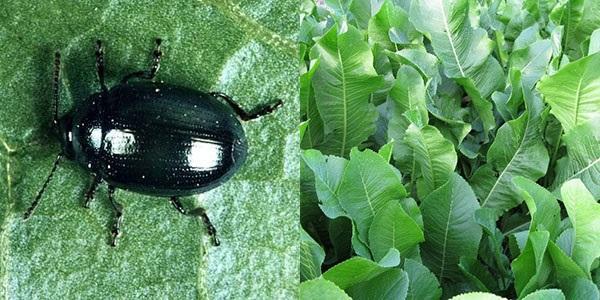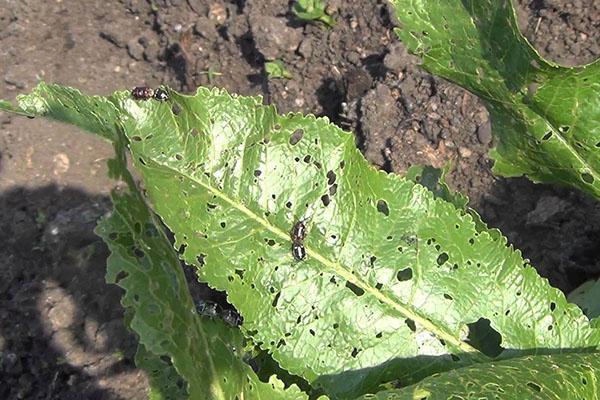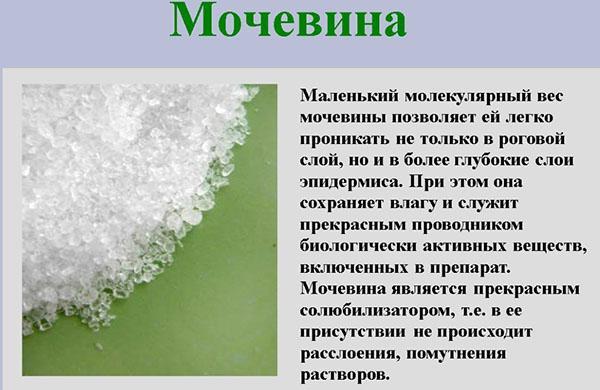Horseradish pests and the fight against them: the experience of professionals
 In the garden, this spice is a frequent "inhabitant", but even it is not immune from diseases and the invasion of dangerous insects. Therefore, horseradish pests and the fight against them occupy an important place in the life of the farmer.
In the garden, this spice is a frequent "inhabitant", but even it is not immune from diseases and the invasion of dangerous insects. Therefore, horseradish pests and the fight against them occupy an important place in the life of the farmer.
Despite its specific taste and smell, the culture is considered very useful. This truth is also understood by arthropods. Who will get this herb? Simple tips from experienced gardeners will help you solve this dilemma and save your harvest.
In cooking, both leaves and horseradish roots are used. Due to its burning taste, a spicy seasoning is made from the roots of the culture, which is colored with beet juice. Fresh foliage is used for marinades, pickles and sauces.
Insatiable horseradish pests and the fight against them

- peat;
- humus;
- manure;
- superphosphates;
- urea;

- ammonium nitrate.
The last mineral fertilizers on the list are added in the fall, when the garden is being prepared for wintering. It is worth knowing that horseradish grows well in sunny areas and tolerates light shade, but not thickets. On waterlogged soil, as well as in areas with a thin layer of arable land, the spice is planted on bulk beds. However, being in favorable conditions, horseradish pests may still appear, and the fight against them will be simply inevitable.
However, being in favorable conditions, horseradish pests may still appear, and the fight against them will be simply inevitable.
On heavy clay soils, the plant branches strongly. When it grows on too dry / light soil, it produces tough and stiff rhizomes. In this case, it is better to choose loam or chernozem with a sufficient humus content for planting it.
Babanukha beetle or shitty leaf beetle when you need to be on the alert
 Any delicacy of such a small insect (3-4 cm) is foliage. This is the main reason why horseradish leaves are all holes in the late summer. The beetle can be recognized by its appearance: dark green elytra with a glossy overflow. However, spicy greens are eaten not by adults, but by young animals that appear in August. New offspring begins to destroy the culture, leaving behind openwork deciduous plates.
Any delicacy of such a small insect (3-4 cm) is foliage. This is the main reason why horseradish leaves are all holes in the late summer. The beetle can be recognized by its appearance: dark green elytra with a glossy overflow. However, spicy greens are eaten not by adults, but by young animals that appear in August. New offspring begins to destroy the culture, leaving behind openwork deciduous plates.
 You can cope with a horseradish leaf beetle by means of insecticides. Some farmers dig up a vegetable garden after harvesting. And only then poisonous drugs are introduced. There are other horseradish pest control methods:
You can cope with a horseradish leaf beetle by means of insecticides. Some farmers dig up a vegetable garden after harvesting. And only then poisonous drugs are introduced. There are other horseradish pest control methods:
- removal of affected foliage with further collection of larvae and adult insects;
- the use of glue traps;
- planting nasturtium, basil, celery in the garden, and marigolds;
- spraying herbs with decoctions of wormwood, onions, millennials, garlic or chamomile;
- sprinkling the planting with a mixture, which consists of ground red pepper and mustard powder (1 tsp each), as well as 1 tbsp. wood ash.
 Due to the fact that these procedures only help in 4 out of 10 cases, they are recommended to be performed three times a year. Moreover, after each treatment, it is important to take a break of 4-5 days. But in most cases, it is recommended to use drugs on a chemical or biological basis.
Due to the fact that these procedures only help in 4 out of 10 cases, they are recommended to be performed three times a year. Moreover, after each treatment, it is important to take a break of 4-5 days. But in most cases, it is recommended to use drugs on a chemical or biological basis.
Before using folk remedies, they should be tested.First, you need to process only one bush and leave it for a day. If no side effects occur, then they start spraying the entire planting.
Cabbage moth - winged predator
 The wings of this insect are 4 cm long and are decorated with graceful brown stripes. For the winter, the moth hides in the ground. When summer comes, females begin to lay eggs on the outside of the leaves. After 10-11 days, caterpillars are formed from them, which eat the pulp of the culture. They leave round holes on the back of the foliage. A month later, the insects pupate, leaving for the winter.
The wings of this insect are 4 cm long and are decorated with graceful brown stripes. For the winter, the moth hides in the ground. When summer comes, females begin to lay eggs on the outside of the leaves. After 10-11 days, caterpillars are formed from them, which eat the pulp of the culture. They leave round holes on the back of the foliage. A month later, the insects pupate, leaving for the winter.
 Gardeners regularly take a number of preventive measures. In addition, they noted effective methods of dealing with cabbage moth:
Gardeners regularly take a number of preventive measures. In addition, they noted effective methods of dealing with cabbage moth:
- plant a perennial plant as early as possible;
- in the fall, dig deeply into the bed, thereby destroying the cocoons hidden in the ground;

- manually catch insects using the light of lamps;
- delete all weeds, and most importantly, the remains of cruciferous crops;
- treat the planting with insecticides.
Many people practice using kerosene in such cases. They moisten several cotton swabs with caustic liquid and spread them between rows. The unpleasant smell of the substance drives moths away from the garden. However, this technique is not used very often, since plants actively absorb volatile substances.
The moth has a unique feature. She is able to adapt to different climatic conditions. Therefore, it becomes difficult to deal with it.
The wavy flea is a small but remote beetle
 The insect is distinguished by two bright stripes of golden color. It is considered one of the most dangerous horseradish pests. Adults are only 3 mm long, making them difficult to spot in the garden. However, you can identify a wavy flea by the through holes in the foliage. Unlike babanukha, they leave openwork patterns already at the beginning of spring.
The insect is distinguished by two bright stripes of golden color. It is considered one of the most dangerous horseradish pests. Adults are only 3 mm long, making them difficult to spot in the garden. However, you can identify a wavy flea by the through holes in the foliage. Unlike babanukha, they leave openwork patterns already at the beginning of spring.
 Since the females lay eggs on the surface of the soil, the larvae first begin to grind the horseradish stalks. As a result, the greens dry up and disappear. There are three ways to cope with such an invasion of a wavy flea:
Since the females lay eggs on the surface of the soil, the larvae first begin to grind the horseradish stalks. As a result, the greens dry up and disappear. There are three ways to cope with such an invasion of a wavy flea:
- Agrotechnical. Observe the rules of crop rotation, regularly water the site during dry seasons, and also strictly adhere to the dosage of fertilization. Timely cleaning of weeds is necessary because insects feed on them before greenery appears.
- Chemical. Treat the area with insecticides, organophosphates or pyrethroids. In addition, the seeds can be moistened with special preparations before sowing.
- Biological. To destroy pests, biological products made on the basis of tobacco extract are used. They should be sprayed with planting during the growing season of plants.
Treatment with chemicals is carried out in 3 stages: before the emergence of seedlings, during the budding period and after the flowering of the culture.
 When carrying out etching procedures, you must adhere to precautions. Do not do this in windy weather. Protect the hand, face and eyes with the appropriate equipment. As a result, the gardener will successfully destroy horseradish pests, and the fight against them will be safe for the person himself.
When carrying out etching procedures, you must adhere to precautions. Do not do this in windy weather. Protect the hand, face and eyes with the appropriate equipment. As a result, the gardener will successfully destroy horseradish pests, and the fight against them will be safe for the person himself.